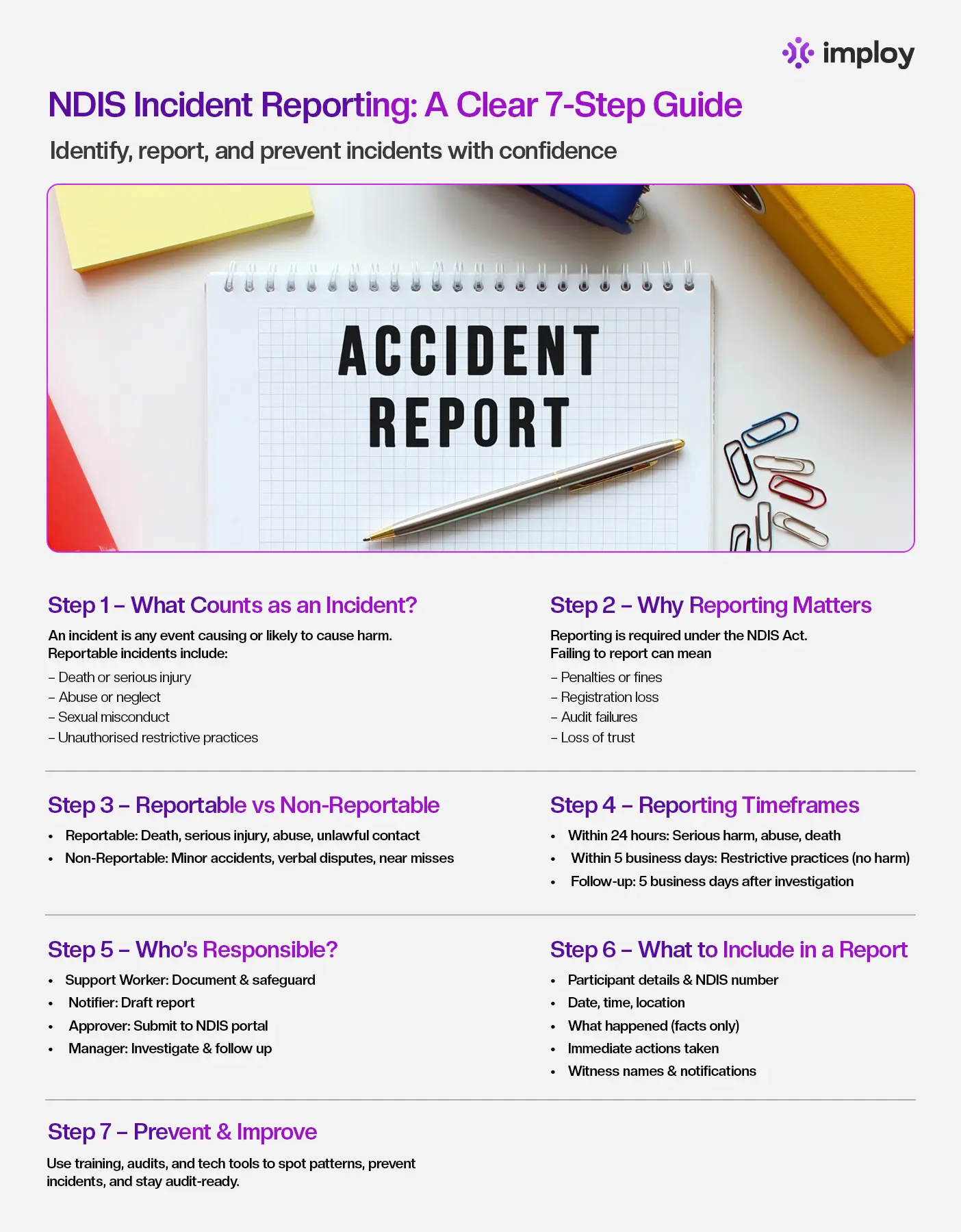Guide to NDIS Incident Reports and Templates
A complete guide to NDIS incident reports, including when to use them, what to include, and how templates help providers stay compliant and responsive.

Effective incident management is a cornerstone of providing high-quality, safe, and compliant services under the National Disability Insurance Scheme (NDIS). A well-structured incident report not only ensures adherence to regulatory requirements but also fosters continuous improvement in service delivery.
This guide explores the purpose, process, and practical tools needed to manage incidents in accordance with NDIS standards, and includes tips on how to use templates effectively.
What Is an NDIS Incident Report?
An NDIS incident refers to any event that causes or is likely to cause harm to a participant during the provision of NDIS-funded supports. These events may occur during transportation, personal care, in shared accommodation, or in the community.
According to the NDIS Quality and Safeguards Commission, a reportable incident includes:
- Serious injury or death of a participant
- Allegations or evidence of abuse or neglect
- Unlawful sexual or physical contact
- Sexual misconduct (including grooming)
- Use of unauthorised restrictive practices
The main goal of reporting is to ensure transparency, protect vulnerable individuals, and enable swift intervention and learning.
Incident Report vs. Progress Notes
What Qualifies as an NDIS Reportable Incident?
NDIS providers are required to report certain types of serious incidents to the NDIS Quality and Safeguards Commission. These are referred to as reportable incidents, and they must be reported within specific timeframes.
Types of reportable incidents include:
- Death of a person with disability – Report within 24 hours.
- Serious injury - Report within 24 hours.
- Abuse or neglect – Report within 24 hours.
- Unlawful sexual or physical contact – Report within 24 hours.
- Sexual misconduct or grooming – Report within 24 hours.
- Unauthorised use of restrictive practices – Report within five business days (or within 24 hours if injury occurs).
These timeframes are strict and failure to comply can lead to serious consequences for providers, including sanctions or loss of registration.
Key Elements of a Comprehensive Incident Report
A well-written incident report should cover the following components:
1. Basic Incident Details
- Date and time of the incident
- Exact location (e.g., participant’s home, community setting)
- Weather or environmental conditions (if relevant)
2. People Involved
- Names and roles of all involved individuals, including staff, participants, and witnesses
- Relationship of each individual to the event
- Contact information for follow-up
3. Description of the Incident
- Objective, factual recounting of the event
- Use of neutral language (no opinions or assumptions)
- Sequence of actions observed
- Quotes from participants or staff (verbatim where possible)
4. Immediate Actions Taken
- Medical care or first aid administered
- Removal from risk or environmental controls put in place
- Notification of family, guardians, or health services
5. Internal and External Notifications
- Who within the organisation was notified (e.g., team leader, compliance officer)
- Whether the incident was reported to the NDIS Commission
- Date and time of all communications and to whom
6. Follow-Up Measures
- Support provided to the participant and staff involved (e.g., counselling, medical review)
- Preventative steps to stop recurrence
- Investigation plans, if needed
- Corrective actions assigned and tracked
7. Sign-Off
- Name and signature of the person completing the report
- Date of submission
- Manager or supervisor sign-off
Keeping these sections clear and complete ensures the report can withstand internal review, audits, and external investigations.
Timeframes: When You Must Report
One of the most critical compliance factors is timing. The reporting clock starts from the moment a staff member or key personnel becomes aware of the incident, not when the incident occurred. Certain events, like serious injuries or abuse, must be reported to the NDIS Commission within 24 hours.
Other incidents, such as unauthorised restrictive practices without harm, require submission within 5 business days. Follow-up actions or investigations must also be logged and submitted within an additional five-day window. Missing these deadlines can result in flags during audits and may impact your registration status.
Best Practices for Writing Incident Reports
Writing clear, professional, and compliant reports is a critical skill for support staff. Here are some essential tips:
1. Be Factual and Objective
Avoid assumptions or speculation. Write only what you directly saw or heard.
Instead of: “John was being difficult.” Write: “John raised his voice and refused to follow instructions, saying, ‘I don’t want to go.’”
2. Use Chronological Order
Present the facts in the order they occurred. This helps identify cause and effect clearly.
3. Avoid Jargon or Technical Language
Use simple, direct language that all stakeholders can understand.
4. Include Direct Quotes
When possible, use the participant’s own words. This offers clarity and can help with context.
5. Review Before Submitting
Check for accuracy, grammar, and completeness. Reports are legal documents and should be treated with care.
Incident Management Systems and Internal Procedures
Every registered NDIS provider must have an incident management system in place. This includes:
- Policies and procedures for identifying, responding to, and recording incidents.
- A reporting structure for escalating serious or reportable incidents.
- Training for staff on how to complete incident reports and recognize different types of incidents.
- A review and response plan to address root causes and implement improvements.
Regular training and scenario-based learning can help staff respond appropriately and document incidents effectively.
Using Incident Report Templates
Templates are an invaluable tool for ensuring consistency, accuracy, and compliance. You can download a ready-to-use free NDIS incident reporting template to simplify documentation and ensure your team meets compliance requirements every time. A good incident report template should:
- Include all required sections outlined above.
- Be editable for digital or physical use.
- Prompt staff with specific fields (e.g., “Describe action taken to ensure participant safety”).
- Be accessible on mobile or cloud-based platforms for on-the-go documentation.
Some providers create different templates based on the type of service (e.g., supported accommodation vs. community support), but all should align with the NDIS Commission's requirements.
What Happens After a Report Is Submitted
Submitting an incident report is only the beginning. Once the report reaches the NDIS Commission, it may trigger an external investigation or follow-up requests. Internally, your organisation should conduct a root-cause analysis to understand what happened and why. It triggers:
- Commission review and possible further inquiry
- Your team’s root-cause analysis
- Corrective actions and documentation
- Participant and family communication
- Staff training updates, if needed
- Long-term archiving for audit readiness
These actions show your commitment to improvement, not just compliance.

How imploy Can Help with NDIS Incident Reporting
Managing NDIS incidents is complex, but imploy makes it simple, fast, and fully compliant.
With imploy, your team can:
- Log incidents instantly from any device-no more paper trails or delays
- Use pre-built NDIS-compliant templates that capture all required details
- Automate workflows from support worker to manager to final submission
- Track deadlines, approvals, and follow-ups with a real-time dashboard
- Store all reports securely in the cloud, ready for audits anytime
- Analyse trends to help prevent future incidents
Providers across Australia use imploy to stay compliant, reduce risk, and build safer services.
Conclusion
Effective incident reporting is essential for NDIS providers aiming to deliver safe, high-quality, and compliant services. Using a structured NDIS incident report template not only ensures accurate documentation but also helps meet strict regulatory standards set by the NDIS Commission.
At imploy healthcare, our platform is purpose-built to support providers with the tools they need to manage incidents confidently. Our incident management solution enables you to document, track, and resolve incidents in one streamlined workflow. Combined with robust document management, providers can securely store and organize all related files, making audits and reviews simpler and faster. Custom form creation allows your team to tailor incident templates based on service type or reporting needs, ensuring consistency across the organization. With compliance tracking built into the system, you’ll always stay on top of your regulatory obligations without added manual effort.
imploy, helps providers go beyond compliance,empowering teams to respond quickly, prevent future risks, and ultimately deliver better outcomes for participants. Discover how imploy can simplify your incident reporting process and elevate your NDIS service delivery.
Frequently Asked Questions
Q1. What qualifies as a reportable incident?
Serious harm, abuse, sexual misconduct, or death, especially during or after provision of supports.
Q2. Can I report via email or phone?
Only if the NDIS portal is unavailable-otherwise, use the online form.
Q3. Can I submit anonymously?
No. A registered person (Notifier or Approver) must submit all official reports.
Q4. What if an incident occurs off-site?
If it’s during NDIS-funded support time, it’s still reportable.
Q5. How should reports be stored?
Secure cloud or internal systems that comply with NDIS privacy standards.
Q6. What’s the penalty for not reporting?
Fines, suspension, or registration revocation, especially for systemic failures.





